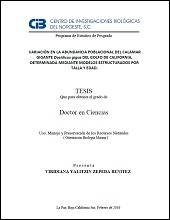Variación en la abundancia poblacional del calamar gigante Dosidicus gigas del Golfo de California, determinada mediante modelos estructurados por talla y edad
Texto completo PDF:
Autor
VIRIDIANA YALITZIN ZEPEDA BENITEZ
Metadatos
Mostrar el registro completo del ítemResumen
Datos de talla y edad del ciclo ontogenético completo del calamar gigante, Dosidicus gigas (d´Orbigny, 1835), en el Golfo de California fueron analizados para describir su patrón de crecimiento. Se ajustaron modelos de crecimiento individual que incluyeron curvas asintóticas y no asintóticas; se utilizó el Criterio de Información de Akaike para seleccionar el mejor modelo e inferencia multimodelo. El modelo general de Schnute (ρ≠0, η≠0) describió mejor el crecimiento de hembras, machos y ambos sexos en datos de talla a la edad. Para machos, de acuerdo con los valores de Δi, los modelos Gompertz (L0), Gompertz (L∞) y Schnute (ρ≠0, η=0) son alternativos para descripción del crecimiento. Al realizar una comparación de los patrones de crecimiento reportados para D. gigas en todo el Pacífico Oriental, se encontró que D. gigas presenta crecimiento no asintótico en la corriente de Humboldt y Domo de Costa Rica y asintótico en la costa occidental de Baja California y Golfo de California. En el análisis de captura estructurada por edades se utilizaron datos de captura a la talla en clases de edad (30 días) y periodos de pesca (meses) con una clave edad-talla y una relación talla-peso conocida. El modelo CAGEAN-JS incluyó datos de captura y tasa de captura para la pesca de 2001 y 2002 provenientes de las tres diferentes flotas calamareras. Se estimó una biomasa total de 798,084 t (I.C. 781,435-837,679 t, P< 0.05) y vulnerable de 638,792 t (I.C. 622,281-678,400 t, P< 0.05); se encontraron tres picos de reclutamiento (mayo y noviembre de 2001 y abril de 2002) con altas abundancias en la clase de edad 5 meses. La mortalidad por pesca mensual llegó a 0.26, aunque la explotación disminuyó en los meses de verano. Los datos de captura estructurada por tallas se analizaron con el modelo CASA para las temporadas de 2002-2003 a 2007-2008 de Guaymas, Sonora. Todas las temporadas fueron principalmente representadas por individuos de 60 a 80 cm LM, excepto 2003-2004 en donde se observaron tres picos y 2006-2007 que se caracterizó por dos picos claramente diferenciados. Se estimó una tasa de explotación de 0.24 a 0.79 entre 38 cm y 89 cm LM. El reclutamiento varió entre las diferentes temporadas de pesca analizadas, el mayor pico (30 cm LM) se observó durante 2002-2003 y el menor en 2004-2005 [...] Size and age data of the complete ontogenetic cycle of the jumbo squid, Dosidicus gigas (d´Orbigny, 1835) in the Gulf of California were analyzed to describe growth pattern. Models of individual growth which included asymptotic and non-asymptotic curves were fitted; Akaike’s Information Criterion and multimodel inference were used to select the best model. Schnute’s model (ρ≠0, η≠0) was the best to describe growth of males, females, and both sexes in size-at-age data. For males, according with Δi values, Gompertz (L0), Gompertz (L∞), and Schnute (ρ≠0, η=0) are alternative models to describe growth. It was found that D. gigas presents non-asymptotic growth in the Humboldt Current and the Costa Rica Dome, and asymptotic growth in the western coast of Baja California and the Gulf of California. In the catch-at-age analysis, catch-at-age (30 days) and fishing periods (months) data were used with known age-size key and weight-at-length relationship. The CAJEAN-JS model included catch and catch rate data for the fisheries of 2001 and 2002 from the three different squid fishing fleets. A total biomass of 798,084 t (I.C. 781,435-837,679 t, P< 0.05) and vulnerable biomass of 638,792 t (I.C. 622,281-678,400 t, P< 0.05) were estimated; three recruitment peaks (May and November, 2001 and April, 2002) were found with high abundance in the 5-month age-class. The monthly fishing mortality reached 0.260, although exploitation decreased during summer months. Catch-at-age data were analyzed with CASA model for seasons 2002-2003 to 2007-2008 from Guaymas, Sonora. All of the seasons were primarily represented by individuals of 60 to 80 cm ML, except for 2003-2003 where three peaks were observed and 2006-2007 which was characterized by two clearly differentiated peaks. A catch rate that ranged from 0.24 to 0.79 in individuals from 38 to 89 cm ML was estimated. Recruitment varied among the different fishing seasons analyzed, the highest peak (30 cm ML) was observed during 2002-2003 and the lowest in 2004-2005 [...]
Colecciones
Ítems relacionados
Mostrando ítems relacionados por Título, autor o materia.
-
PROMOCIÓN DEL PERIFITON PARA EL CULTIVO DE CAMARÓN BLANCO: HACIA UNA ACUICULTURA ECOLÓGICA
DOMENICO VOLTOLINA LOBINA; JUAN MANUEL AUDELO NARANJO; MARIA DEL ROSARIO PACHECO MARGES -
Suelo y Erosión
YOLANDA LOURDES MAYA DELGADO


